Historians divide history into large and small units in order to make characteristics and changes clear to themselves and to students. It’s important to remember that any historical period is a construction and a simplification. In Asia, because of its huge land mass and multiple diverse cultures, there are several overlapping timelines. Also, for the same reason, different regions have different histories, but they all intersect — in myriad ways — at different points in history. Below are some important basics to get you started.
Geographical divisions
Here are the major subdivisions currently used in textbooks or in curatorial departments in art museums. Keep in mind that these categories are complicated by previous divisions, some of which reflect a violent history, such as campaigns of colonization by Western or Asian countries.
Central and North Asia, comprising territories bordered by the Caspian Sea in the west, China in the east, and Afghanistan in the south (which is at times considered part of the Central Asian region).
Unfamiliar with the term “North Asia”? There is a historical explanation. North Asia is better known as Eurasia, coinciding largely with Siberia, which became a part of Russia in the 17th century. “North Asia” is still an under-explored area within studies of Asia because historically it has been integral to studies of Russia, a transcontinental country whose leaders nevertheless endeavored to shape it as a European power.
West Asia, comprising Iraq (in ancient times, Mesopotamia), Iran (whose territory previously encompassed Persia), Syria and the Eastern Mediterranean (today’s Cyprus, Lebanon, Israel, Palestine, Gaza Strip, and West Bank), the Arabian Peninsula (comprising Yemen, Oman, Qatar, Bahrain, Kuwait, Saudi Arabia, Jordan, and the United Arab Emirates), and Anatolia and the Caucasus (today’s Turkey, Armenia, Azerbaijan, and Georgia).
East Asia, spanning Mongolia, mainland China, Macau, Hong Kong, Taiwan, Japan, and North and South Korea.
Central and West Asia are better known as the “Near East” and the “Middle East”. By the same logic, East Asia has been referred to as the “Far East.” All these terms are Western-centric, reflecting European geopolitics. They are problematic terms because they isolate and lionize one vantage point. For the peoples of the “Far East,” for example, their territories and cultures are not “Eastern” nor “far.” Quite to the contrary, they represent the “home base” from which world geography is envisioned differently, complete with its own cultural and sociopolitical biases.
South and Southeast Asia, consisting of the countries that are geographically north of Australia, south of China and Japan, and west of Papua New Guinea. These countries are Malaysia, Cambodia, Indonesia, Philippines, East Timor, Laos, Singapore, Vietnam, Brunei, Burma, and Thailand. South Asia, also known as the Indian subcontinent, comprises the sub-Himalayan countries of Sri Lanka, Pakistan, Afghanistan, Bangladesh, Nepal, India, Bhutan, and the Maldives.
South Asia was often conflated with the vague and politically motivated category of “India,” from the perspective of Western powers (Portuguese, French, Dutch, and British) who dominated and colonized parts of the region at different points in time, as outlined later in this essay.
Cultural divisions
A radically different way of looking at Asia’s cultural histories is to trace major transcultural phenomena — from religious to commercial — that spanned multiple periods and geographical regions. Such phenomena include:
- Buddhism, which developed in India in reaction to the established religion, Hinduism, and subsequently spread to other countries in South, Southeast, and East Asia. From the 6thcentury B.C.E. to the present day, Buddhism shaped various aspects central to these Asian cultures, from principles of government to visual and material culture.
- See the Smarthistory resource on Hinduism + Buddhism.
- Islam, founded by Muhammad in the early 7th century C.E. at Mecca (in modern-day Saudi Arabia), spread over the centuries in Central and Western Asia all the way to the Pacific nation of Indonesia, and reached non-Asian territories in North Africa and the Iberian Peninsula. One can trace the history of the Islamic world and its deep imprint on many Asian cultures and on pan-regional cultural phenomena within Asia and beyond.
- See the Smarthistory resource, Introduction to Islam
The Silk Road, named as such only in the 19th century, is a network of trade routes harkening back to the 2nd century B.C.E., which connected, over the centuries, territories from Eastern China to Southern Europe and North Africa. Although occasioned by trade, especially in silk, these pan-Asian routes had a significant influence on local cultures and enabled cross-cultural encounters.
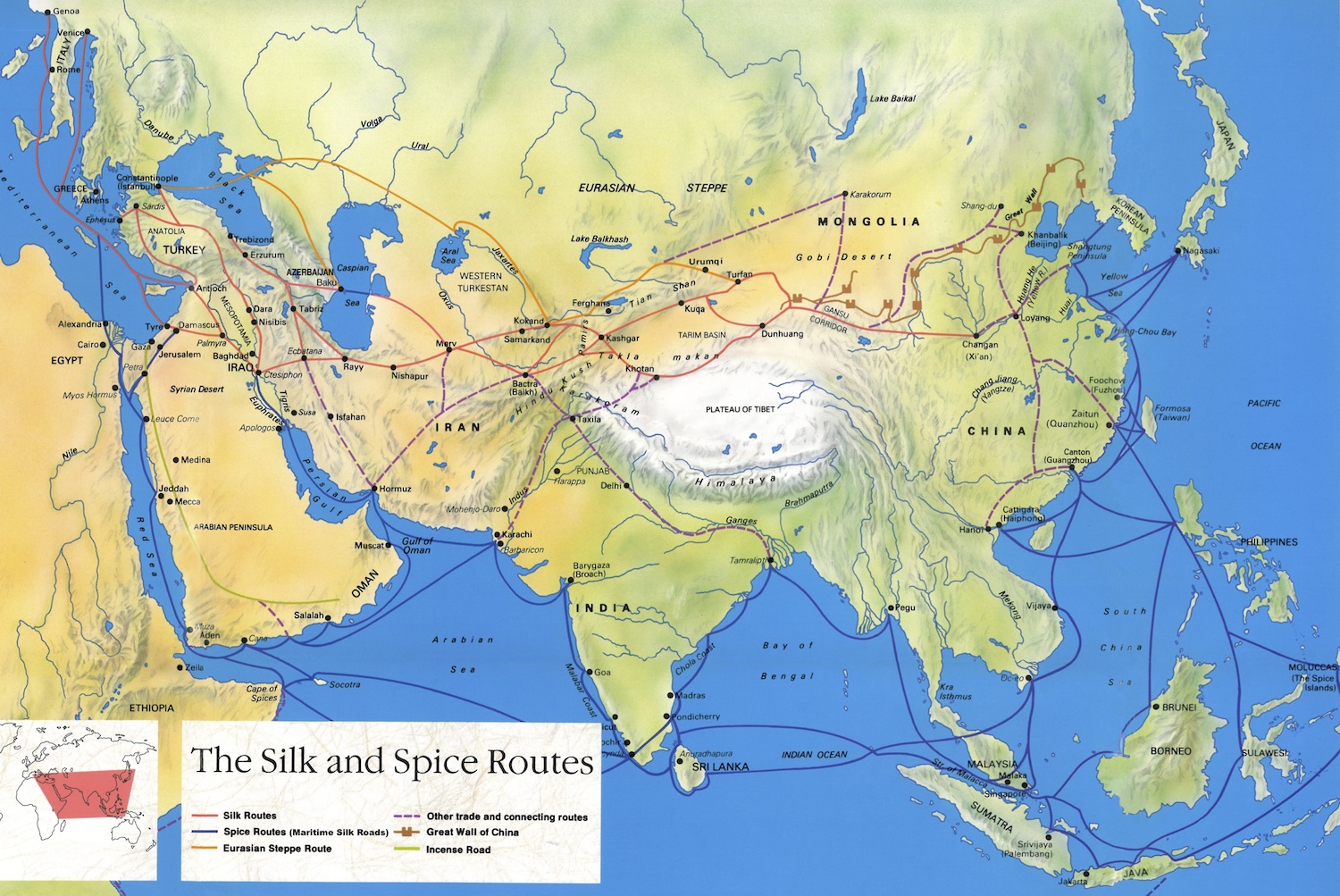
Silk and Spice Routes (image: UNESCO, Silk Roads: Dialogue, Diversity & Development)
Prehistoric (before c. 2500 B.C.E.)
The term “prehistoric” refers to the time before written history. In Asia as elsewhere, this is the period when the most fundamental aspects of human civilization as we know it are formed and developed. Communities transition from hunting and gathering to taming animals and cultivating land, especially as irrigation is mastered. Prehistoric men and women create complex tools, pottery, and clothing, build homes and monuments, and develop language and rituals expressed through diverse forms of art and eventually through writing.
In Mesopotamia (present-day Iraq), as early as 8000 B.C.E., sedentary agricultural communities are established. By 2500 B.C.E., monumental architecture testifies to the development of hierarchies of social and political power. Writing — newly invented — provides invaluable information about city-states, rulers, and their reigns. Invented by the Sumerians, the cuneiform system is the earliest writing we know. It is no coincidence that cuneiform inscriptions were impressed onto tablets made of clay -—one of the earliest and most ubiquitous mediums for cultural transmission and artistic expression.
In China, writing is first seen as inscriptions on oracle bones, a hallmark of the Shang dynasty (1700-1027 B.C.E.). Made of the shoulder blades of oxen or the underbellies of turtles, oracle bones — as their designation indicates — were used for divination (foretelling the future). Up to that point, China had already developed a rich culture ranging from pottery and clay figurines to carved jade and bronze ritual vessels — the latter of which would have a lasting influence on Chinese art and design. Also, a central motif of Chinese art — the paired dragon and tiger, symbolizing water and wind in Chinese cosmology — first appears during this period. The earliest known example is a river-shell mosaic representation from c. 5300 B.C.E., excavated in a royal grave at Xishuipo, Henan province.
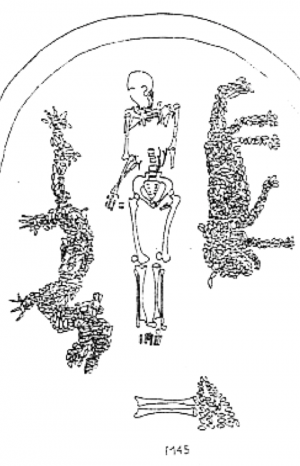
Representations of dragon and tiger, mosaic of river clam shells, c. 5300 B.C.E., royal grave no. 45, Xishuipo, Henan province (diagram: Feng Shi, “Henan Puyang Xishuipo 45 Hao Mu de Tianwenxue Yanjiu,” Wenwu, vol. 3, pp. 52-69).
Ancient – Conquests, New Empires, and New Religions (c. 2500 B.C.E. to 650 C.E.)
The ancient world is often thought of as a cradle of today’s civilizations. It is home to important “firsts” and to changes that shaped cultural practices and artistic expressions. In Asia as elsewhere, it is a period of military conquests that contributed to the formation of the first great empires, which quickly became cultural hubs — sites of effervescent intellectual, spiritual and artistic life. The empires formed in this period extend across and beyond the geographical divisions outlined above.
The first of these empires is that of Cyrus the Great, who founded the multi-state Persian empire in the 6th century B.C.E. and maintained control over a vast territory, that grew to encompass the (European) Balkans in the west and the Indus valley in the east. But empires come and go, and cultures transform in the process. Much of Cyrus’s empire was conquered centuries later by Alexander the Great, who is known to have nurtured great admiration for Cyrus. Alexander’s presence in West and Central Asia in the 3rd century B.C.E. had a lasting impact on visual representation in those regions and beyond. Known as Hellenism, this phenomenon brought characteristics of Greek art — especially its synthesis of naturalism and idealism — to local centers of cultural production, where they were emulated and transformed.
In the ancient region of Ghandara (today’s Northwest Pakistan), this compelling fusion was at work, centuries later, in devotional images of Buddhas and bodhisattvas, such as the one below. Notice the subtly plump body, the expressiveness of the facial features, and the harmonious geometry of the clothing drapery. But human representations of the Buddha were not always the norm. In fact, in the earliest Indian images of the then-new religion, Buddha’s presence was indicated by means of footprints or an empty space under a parasol. The Gandhara tradition was the first to develop human images of the Buddha. As Buddhism received increasingly significant patronage in South Asia, other styles emerged, marking a transition from narrative to devotional images. Known as a “Golden Age,” the Gupta empire at its zenith (319 to 543 C.E.) saw the creation of “ideal” images of the Buddha, which spread along the Silk Road to China and beyond.
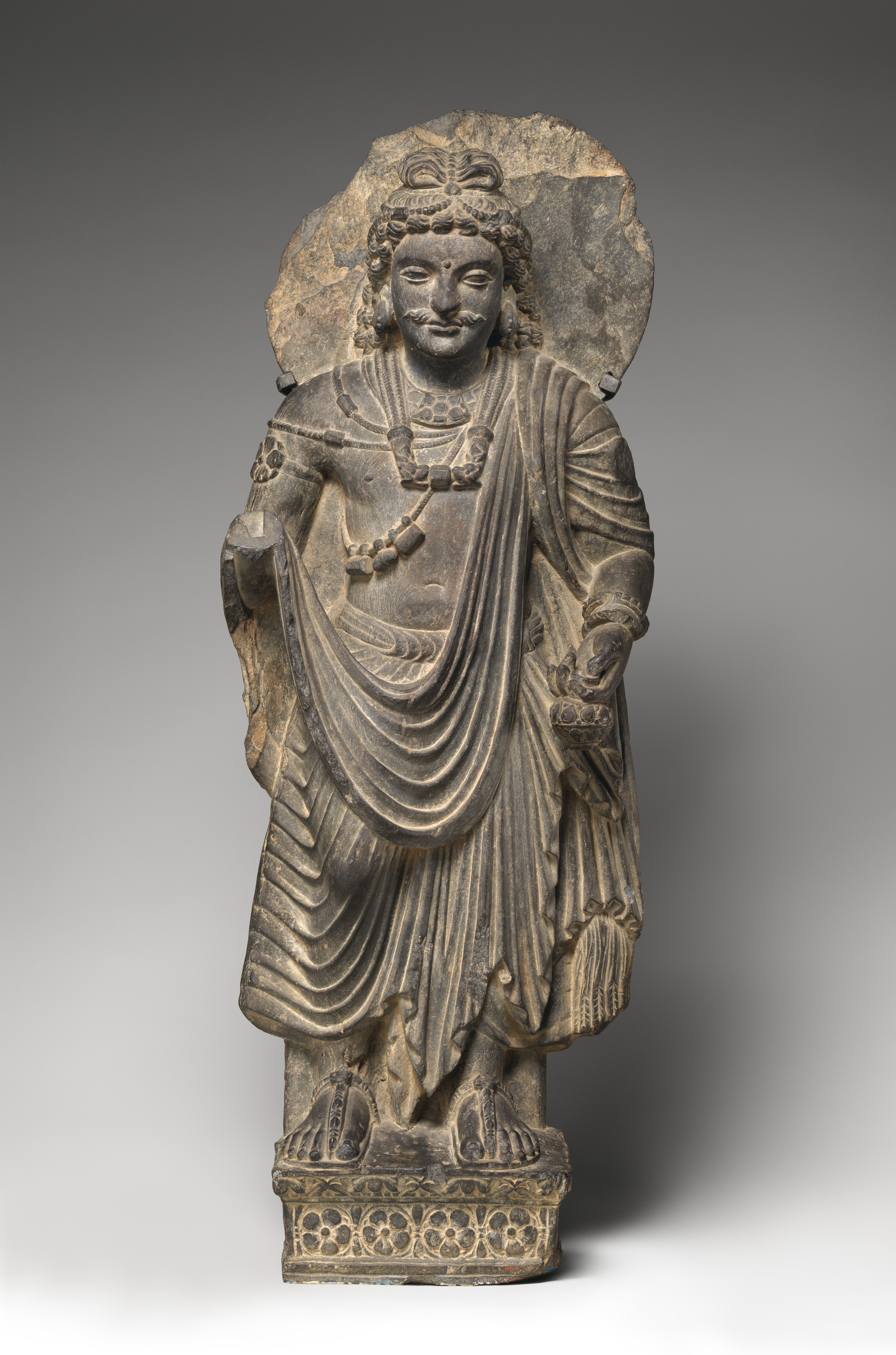
Standing Bodhisattva Maitreya (Buddha of the Future), c. 3rd century, Pakistan (ancient region of Gandhara), schist, 80.7 cm high (The Metropolitan Museum of Art)
Middle Ages – Realms and Societies (c. 650 C.E. to 1500 C.E.)
The concept of the “Middle Ages” has been developed in relation to Western cultures to mark a period between antiquity and the Renaissance that presents a degree of consistency not encountered in Asia during the same period. In the “Middle Ages” as during other timeframes, different Asian regions had considerably different histories. That said, across Asia, this was a time of remarkable developments in communication and science. For example, metal movable type had been invented in China by the 12th century (about 300 years before Gutenberg’s movable type press in Europe). Advances in technology and science — such as the invention and improvement of gunpowder — were put in the service of warfare, which led to the consolidation of the political power of empires. One of the most prominent was the Mongol Empire (1206–1405), founded by Genghis Khan. At its height, the Mongol empire controlled much of Eurasia and the Silk Road and saw the transcontinental dissemination of movable type printing and the flourishing of local cultures, all largely due to Mongol patronage.
Another major catalyst of cultural and artistic activity was the formation of the Islamic empire in Central and West Asia, starting around 634 C.E. It is during this period that the Islamic political structure known as the caliphate emerges. Typical of new leaders seeking to legitimize political power, the 7th– and 8th-century caliphs used art and architecture to mark their presence and shape the cultural identity of their expanding territories.
A striking example is the Great Mosque (Friday Mosque) of Damascus in today’s Syria — one of the oldest in the world and larger than any other mosque built before it. Constructed under the patronage of the Umayyad caliph al-Walid I (who ruled from 705–715), the mosque occupied a site that once housed a temple dedicated to a Syrian god, then a Roman temple dedicated to Jupiter, and later a church dedicated to John the Baptist. As the site itself had been considered holy during so many earlier political and cultural regimes, the Great Mosque of Damascus brought significant prestige to the caliphate. The Great Mosque has three minarets, all from different historical periods, and a prayer hall modeled on early Christian basilicas. Walls are adorned with opulent mosaics attributed to Byzantine craftsmen and possibly illustrating passages from the Qur’an.
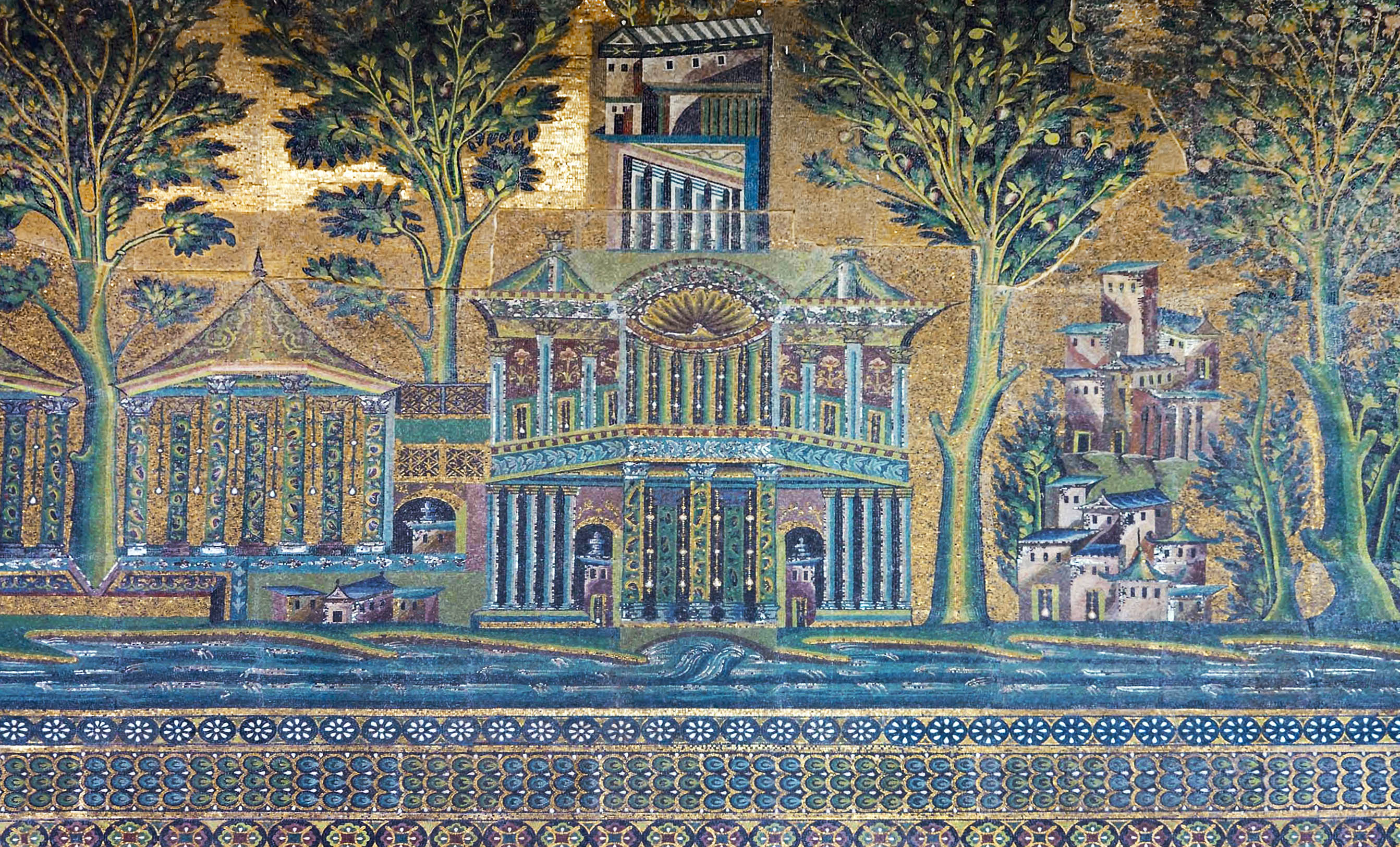
Mosaic, Great Mosque of Damascus (photo adapted from: american rugbier, CC BY-SA 2.0)
It is in this period that Islam is introduced to (parts of) China. In fact, this is a time of significant encounters and exchanges. For example, in 607, the first Japanese envoy is received by the Chinese imperial court. This diplomatic relationship opened a channel of cultural dissemination that had a lasting influence on Japanese political thought, literature, and the arts. Shortly thereafter, the Tang dynasty is established in China, leading to a cultural “golden age.” Tang-dynasty poetry is among the most extraordinary literary achievements in our world heritage, and will become an extremely rich source of subject matter for Chinese (and Japanese) painters throughout the centuries. Ultimately weakened by rebellions, the Tang dynasty gave way to a succession of dynasties that bring into focus the ethnic and cultural diversity of the vast territory controlled by China.
For example, between the Song and Ming dynasties, the Yuan dynasty was established by the Mongol Kublai Khan and maintained power for almost a century before it fell, a result of tension between its roots in the culture of the Mongol empire and its efforts to become a legitimate part of Chinese culture. Although short-lived in comparison with the relatively peaceful and prosperous Ming dynasty that would replace it, the Yuan dynasty saw the emergence of now-classical figures in Chinese visual arts, notably the so-called “four masters of the Yuan dynasty” (Huang Gongwang, Ni Zan, Wang Meng, and Wu Zhen) — experimental ink painters cultivating ideals of individual expression. Their distinctive styles — compare the restrained brushwork of Ni Zan versus the elaborate, tapestry-like compositions of Wang Meng — inspired and challenged generations of Chinese painters.

Left: Ni Zan, Six Gentlemen 六君子图, 14th century, ink on paper (Shanghai Museum); right: Wang Meng, Ge Zhichuan Moving to the Mountains 葛稚川移居圖, 14th century, ink on paper (Palace Museum, Beijing).
South of China, another remarkable society flourished, that of the Khmers. On the territory of today’s Cambodia, the Khmers founded the Hindu-Buddhist Angkor empire, which grew to vassalize much of mainland Southeast Asia as well as parts of Southern China. The cultural “golden age” of the Khmers’ empire, datable to the 12th century, led to the construction of one of the world’s largest religious monuments, the Angkor Wat, occupying over 400 acres in the Khmer capital of Angkor. Originally dedicated to the Hindu god Vishnu, it gradually became a Buddhist temple as Buddhism was embraced by Khmer rulers, especially king Jayavarman VII—one of the most powerful leaders of the Angkor empire. With its many temples blending Hindu and Buddhist iconography, Angkor reflected the creative tension of a multicultural empire in its spectacular architecture.
Early Modern – Self-Fashioning and Transcultural Encounters (c. 1500 – c. 1850)
As old empires consolidated their power and new rulers and dynasties emerged, this period saw some of the most remarkable expressions of self-fashioning. Coined by art historian Stephen Greenblatt with respect to the Western Renaissance (in particular, 16th-century England), “self-fashioning” is an apt term to describe cultural processes in Asia around the same period. Self-fashioning was a response to the power struggles of a world increasingly rich in cross-cultural encounters, ranging from military tensions and diplomatic missions to commercial exchanges along the Silk Road to cultural and scientific collaborations.
1501 marked the beginning of the Safavid rule in Persia — whose fascinating history presents a generative blend of transculturalism and self-fashioning. Safavids continued to rule for over two centuries; at its height, their empire comprised today’s Iran, Azerbaijan, Bahrain, Armenia, eastern Georgia, Iraq, Kuwait, and Afghanistan, as well as parts of Pakistan, Syria, Turkey, Turkmenistan, and Uzbekistan. Over this vast territory, many cultures intersected and the Safavids utilized architecture and the arts as a means to strengthen their control. The capital of Isfahan concentrated the empire’s cultural power by providing resplendent examples of Safavid architecture and visual and material culture, thereby constituting a “microcosm” of the Safavid world.
A telling example of how the Safavids harnessed their multicultural reality is a curious and significant gift, presented in 1611 by the Safavid Shah Abbas in the memory of his spiritual ancestor, the Sufi Sheik Shaykh Safi al-Din, to be housed in his shrine at Ardabil. The gift consisted of over one thousand Chinese Ming-dynasty blue-and-white porcelain objects and is—to this day—one of the two most important collections of such ceramics outside China itself.
Why would a Safavid ruler donate and display Chinese artifacts in a gesture to honor the Safavids’ spiritual founder? It has been argued that this is a prime example of “porcelain diplomacy.” In other words, the Safavid shah sent a public message that his cosmopolitanism was a sign of his power on the world stage, signaled by his ownership of so many fine examples of coveted Chinese porcelain, now re-purposed as an offering to an important Safavid shrine. The gift was such an important part of the Ardabil architectural complex that a “Chinese [porcelain] house” (Chini Khaneh) was built to feature the ceramics in hundreds of specially-designed shelves carved into the walls.
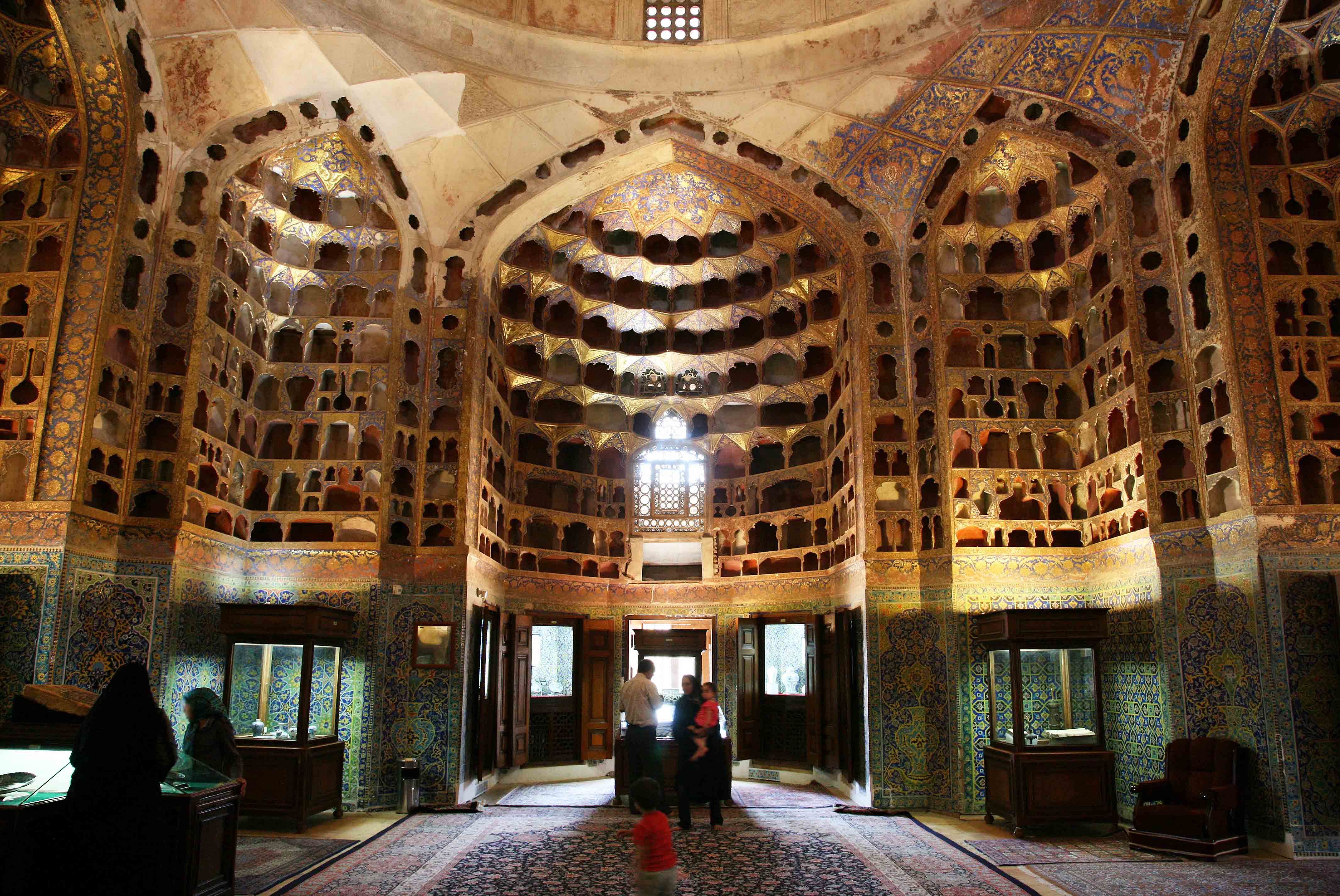
Built-in shelves for Chinese porcelain, Chini Khaneh, Ardabil, Iran (photo: © UNESCO/Iran Images/Mohammad Tajik, Sheikh Safi al-din Khanegah Shrine Ensemble, in the City of Ardabil, Iran)
In China, the Ming dynasty — under whose rule the production and global dissemination of blue-and-white porcelain flourished — gave way, in 1636, to the Qing dynasty. Led by Manchu emperors and ruling over a vast and culturally diverse territory, the Qing dynasty placed strategic emphasis on multiculturalism in a way that calls to mind similar efforts by the Safavids. The Qing court became an important patron of the arts, largely characterized by grandeur, opulence, and eccentricity of design.
In Japan, the early 17th century marked a turning point as the Tokugawa family took control of the country and began their long and relatively peaceful and prosperous shogunate. The Tokugawa ruled from Edo (present-day Tokyo), which gives the name for this period and where a vibrant urban culture developed. It was, to some extent, a foil to Kyoto, where the emperor continued to live, secluded in his palace.
Mostly shielded from the outside world (in contrast to Safavid Persia and Qing-dynasty China), the poets and painters of Edo-period Japan drew inspiration not only from nature and from the classics, but also from everyday life, developing the first so-called genre paintings (portrayals of common people engaged in routine activities). Within this category, a spectacular subtype was the rakuchū rakugai zu (“scenes in and around the capital”), depicting Kyoto and its suburbs in ways that mixed anecdotal detail from street life with vistas of the capital’s famous locations and seasonal festivals.
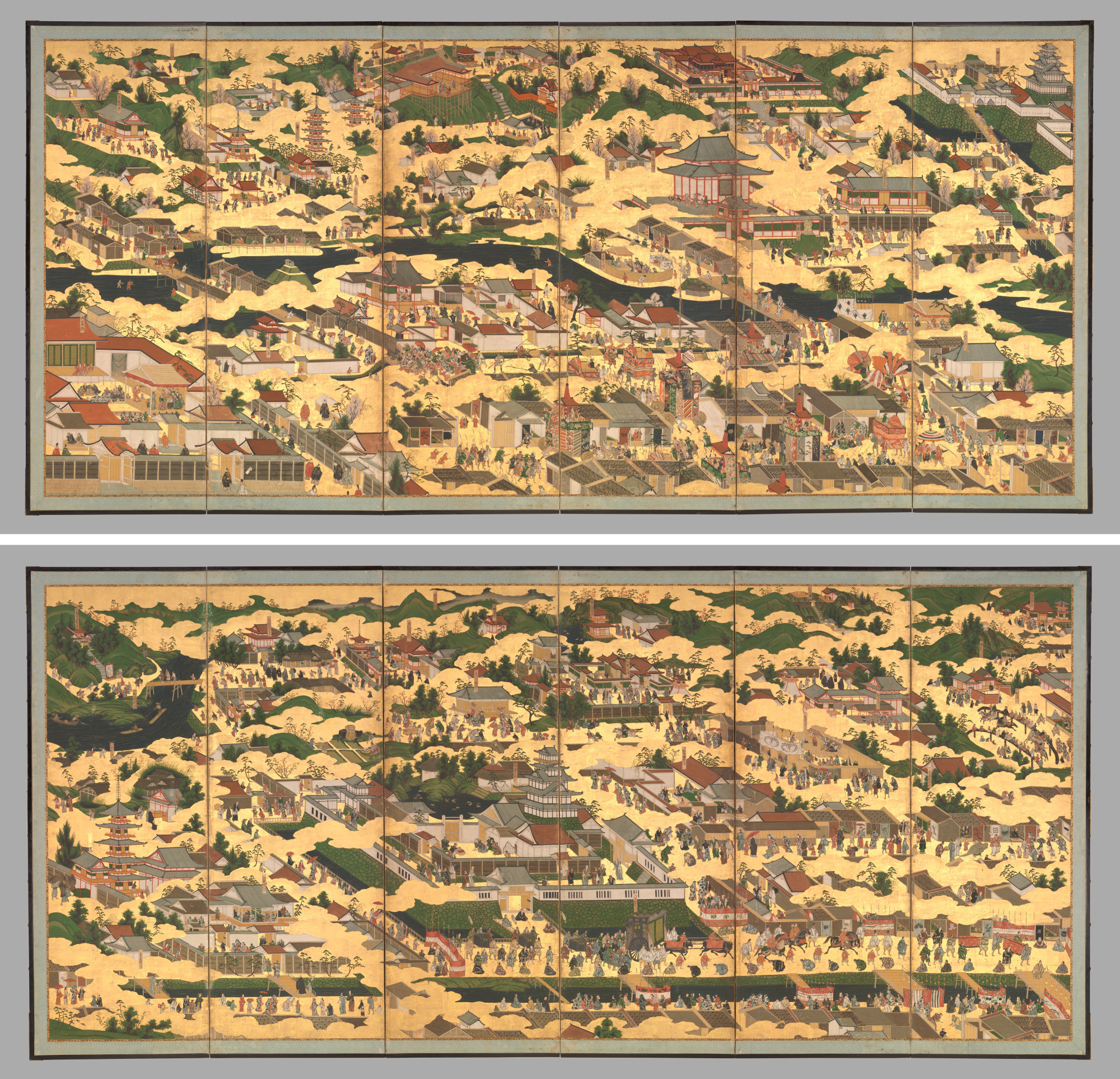
“Scenes in and around the capital” (rakuchū rakugai zu 洛中洛外図), Edo period, 17th century, six-panel folding screens, ink, color, gold, and gold leaf on paper, 170 x 366.2 cm each (Mary Griggs Burke Collection, Gift of the Mary and Jackson Burke Foundation, 2015, Metropolitan Museum of Art)
Modern (after c. 1850)
The 19th century brought major changes to Asia’s many worlds. By the mid-20th century, societies had undergone watershed transformations. In Japan, following the 1853 “black ship” expedition of American commodore Perry who demanded Japan’s “opening” to the world and the 1868 revolt that put an end to the Tokugawa shogunate and restored imperial power, the arts reflected an unprecedented broadening of styles and foreign influences, as well as imperial ambitions and rising nationalism that culminated during WWII. In China, the fall of the Qing dynasty in 1912 marked the end of the country’s imperial history that had stretched for over two thousand years. The rise of the Communist Party, China’s participation in the first World War, and the Japanese aggressions in Manchuria all led to the country’s involvement in WWII and the subsequent establishment of the People’s Republic led by Mao Zedong. In response to centuries of autocratic and colonial rule, communism became a rallying point for revolutionaries in countries across Asia, each drawing on Karl Marx’s manifesto, as well as the 1918 October Revolution in Russia that had been led by Vladimir Lenin.
Soviet control altered local cultural and artistic expression to an even greater degree than the pre-revolution tsarist rule of the so-called Turkestan (comprising present-day Afghanistan, China’s Xinjiang province, Kazakhstan, Kyrgyzstan, Mongolia, eastern Russia, Tajikistan, Turkmenistan, and Uzbekistan). Exploited for its natural resources, then subject to Soviet collectivization and mechanization, these regions struggled to maintain their multiple local identities, especially as mosques were closed, Arabic script was gradually replaced by the Latin and the Cyrillic scripts, and traditional crafts workshops were transformed into factories.
Posters and advertisements from Soviet-controlled Asia show the strong influence of modernist design (function-oriented form, bold compositions on a grid system, and visually striking typefaces) and illustrate how art was used aggressively as a tool for propaganda. Such images serve as a reminder of the power of images, which has been, and still can be, used to seduce, manipulate, and even erase and rewrite history.
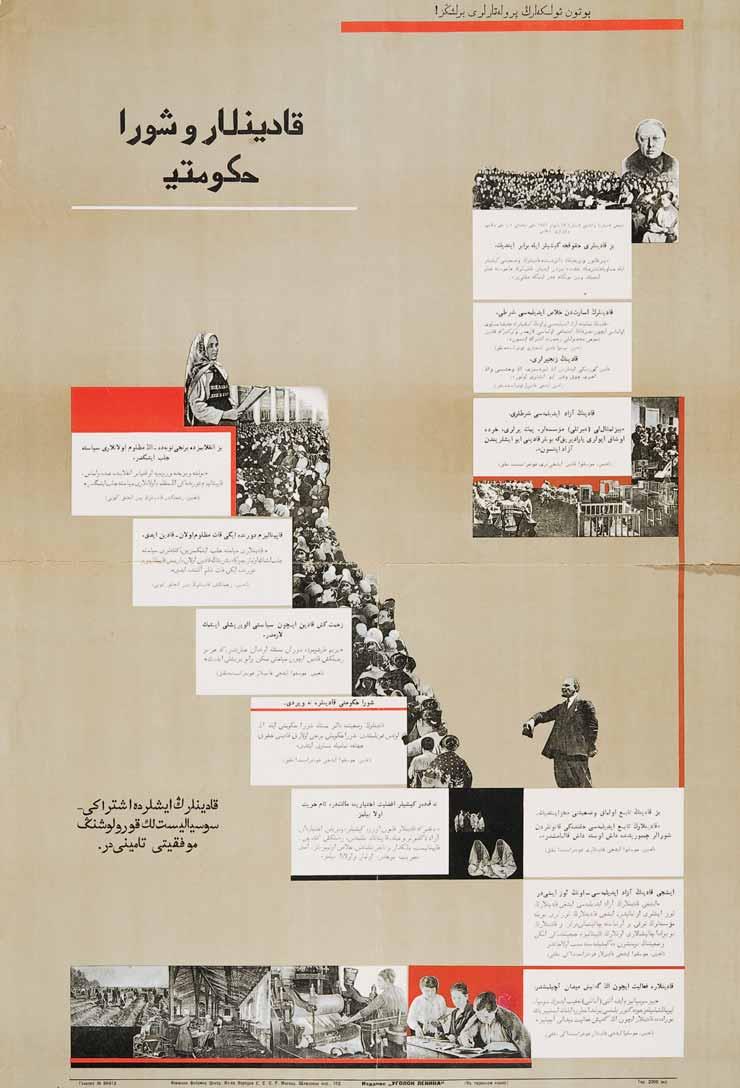
Unknown artist, “Participation of women in work (…)”, Turkic text (Arabic script), book factory of the Central Publishing House of USSR Nations , 920s, print run: 2000 copies, 108.4×70 cm. (image: “Уголок Ленина,” Russian Perspectives on Islam)
Colonization is another phenomenon that has had enormous consequences on the cultures and societies of Asia in the modern period. During the long 19th century, Cambodia, Laos, and Vietnam were colonized by France; the so-called Indian subcontinent was under British rule; and today’s Indonesia became a Dutch colony known as the Dutch East Indies. Not unlike the Soviet situation in central and North Asia, the European powers in colonial South and Southeast Asia exploited resources and dictated what was produced, how it got produced, and for what purposes. In the process, colonization problematized and eroded local craftsmanship and artistic traditions. However, colonial powers also invested in learning and recording local histories, which in turn strengthened the identity and self-image of colonized societies — a phenomenon reflected in the consciously non-Western art of some 20th century artists.
For example, in India, the swadeshi movement encouraged artists to envision a non-Western, solely Indian art. However, in the case of the Bengal School of painting that came out of this context, European and modern developments still found their way in the underpinning concepts of the new school. The swadeshi-inspired Bengal School shared many characteristics with the contemporaneous Nihonga (literally, “Japanese painting,”) in Japan. Like the Bengal School, Nihonga was defined in opposition to Western painting but bore the influence of Western ideas and techniques. Some proponents and practitioners of both schools knew and inspired one another.
Contemporary Asian Cultures in a Global Context
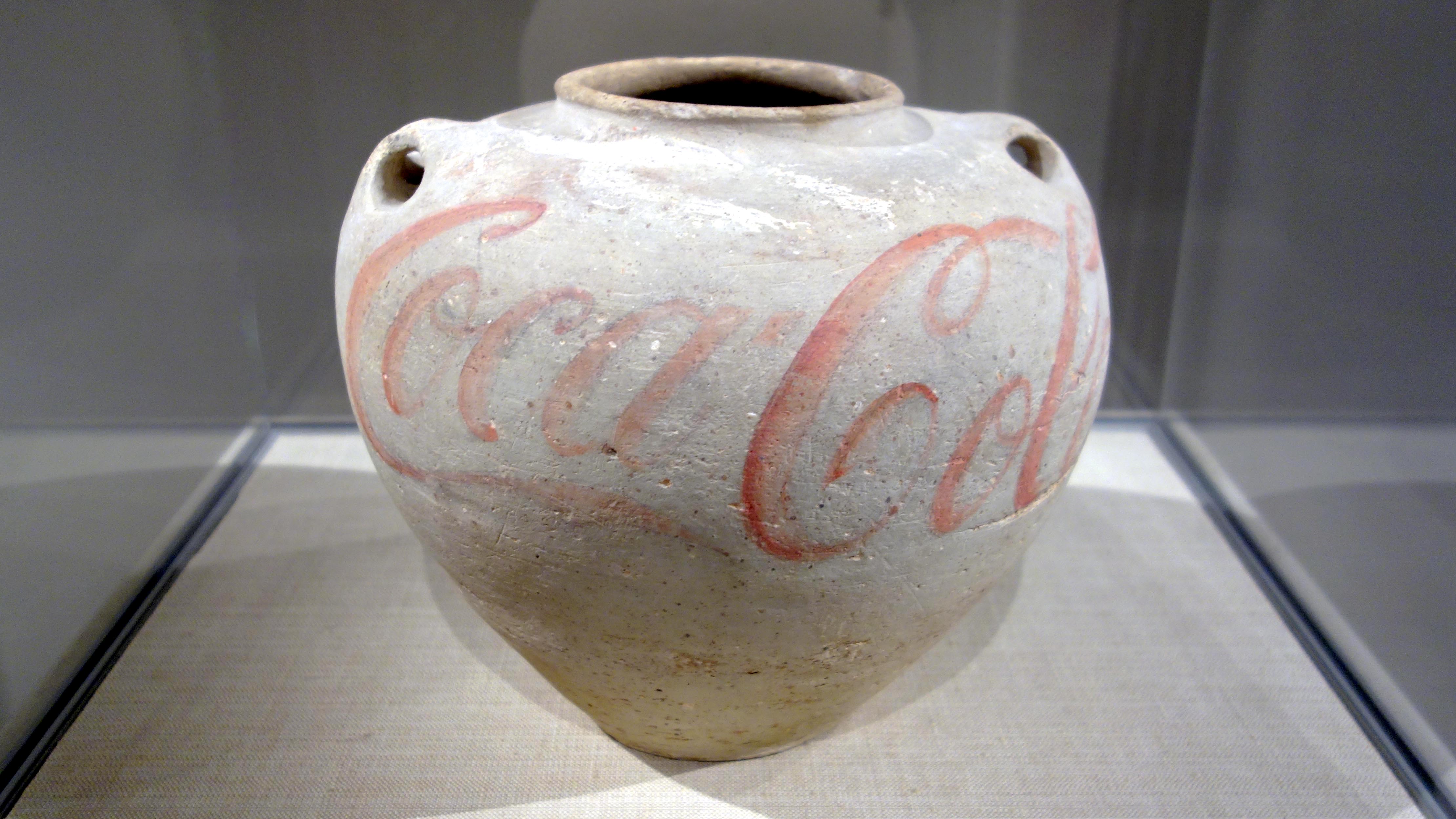
Ai Weiwei, Han Jar Overpainted with Coca-Cola Logo, 1995, earthenware, paint, 25.1 × 27.9 × 27. 9 cm, © Ai Weiwei (image: Steven Zucker, CC BY-NC-SA 4.0)
In an interconnected art world whose online presence and international fairs and biennials make regional identities more elusive than ever before, contemporary Asian art presents an extremely diverse range of individual styles and expressions. That said, internationally acclaimed artists like Subodh Gupta (Indian, b. 1964) and Takashi Murakami (Japanese, b. 1962) continue to explore the creative tension between tradition and innovation and between the global and the local.
Working within the same paradigm, artists like Ai Weiwei (Chinese, b. 1957) combine references to traditional cultural elements with an activist agenda (which, for Ai Weiwei, has resulted on occasion in his arrest in China). Ai Weiwei also exemplifies the practice, embraced by many contemporary artists across Asia, of working in a variety of mediums, ranging from site-specific installations to film and curatorial projects.

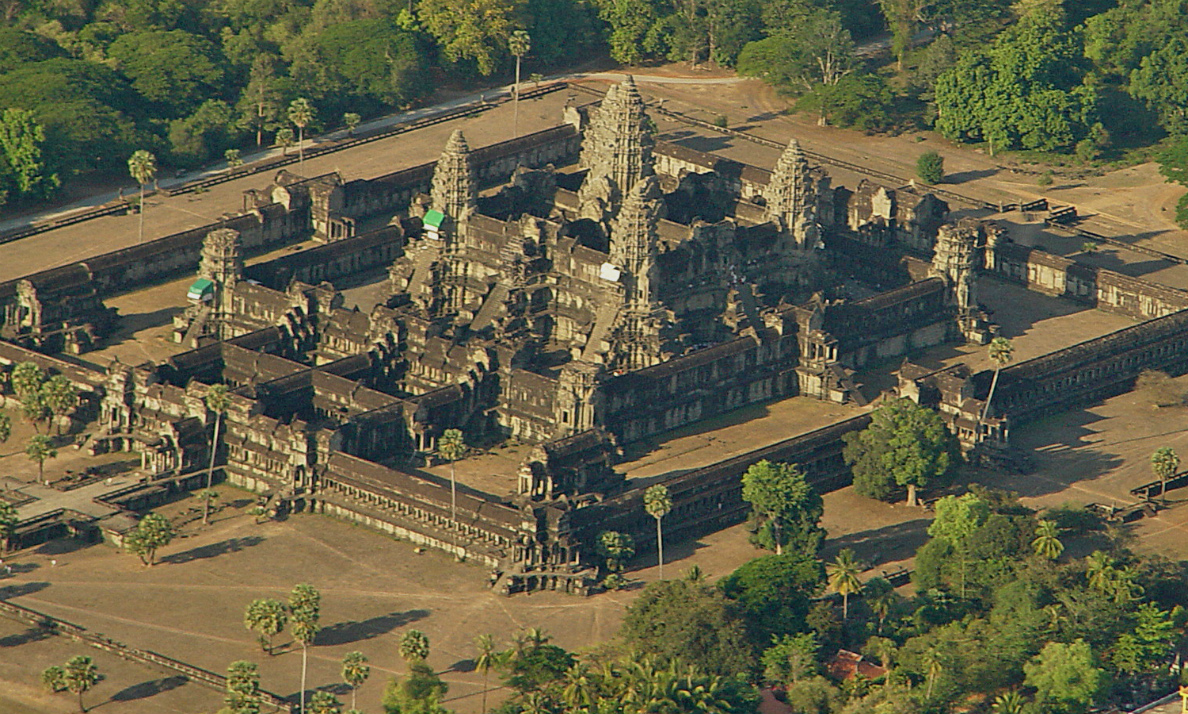
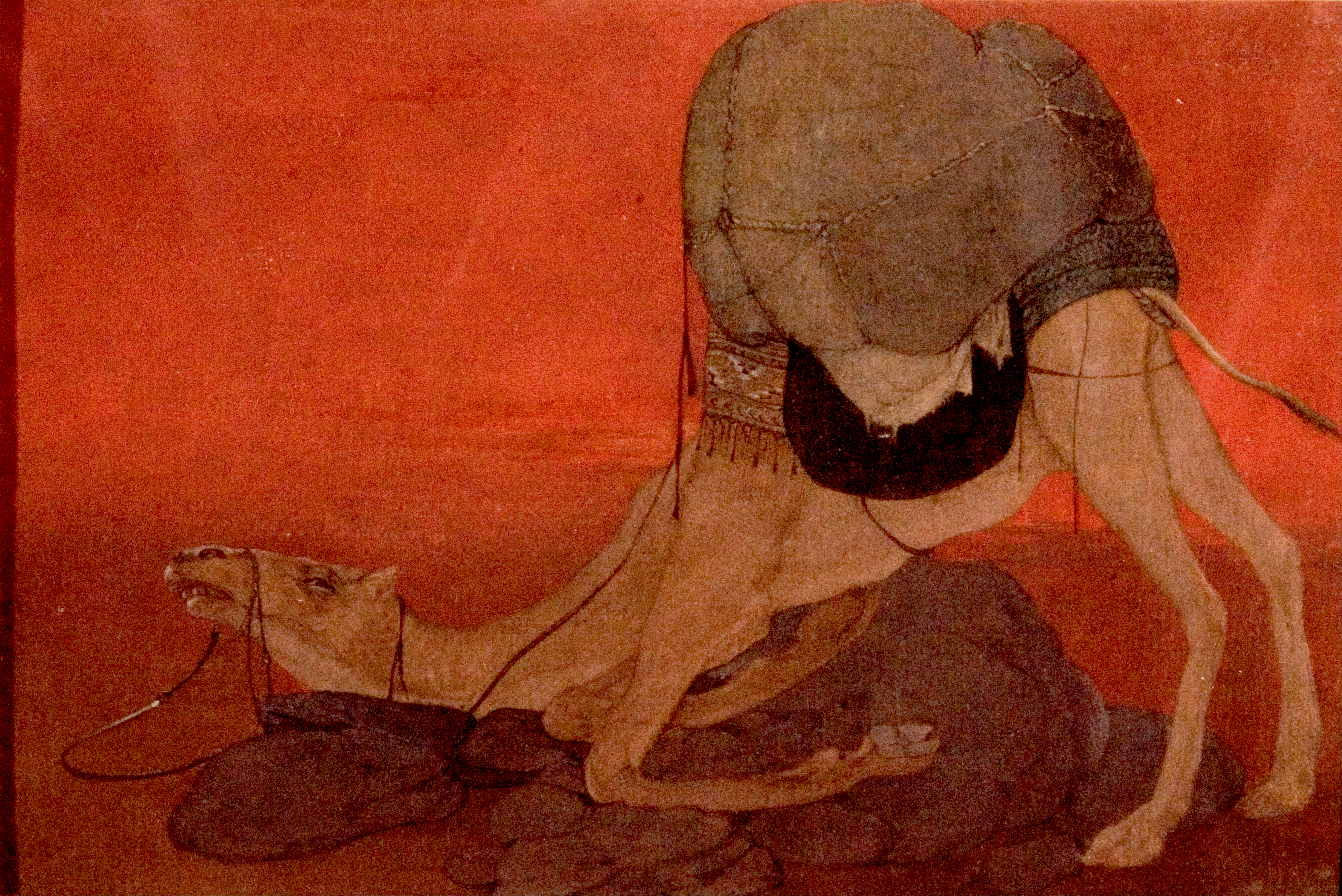



No comments:
Post a Comment